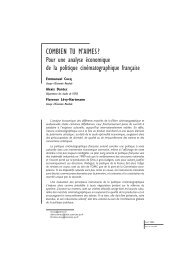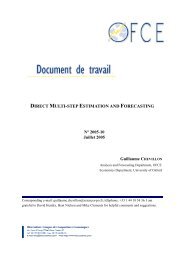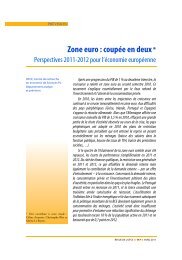N° 2005-09 Juin 2005 Guillaume Daudin* Jean-Luc Gaffard ...
N° 2005-09 Juin 2005 Guillaume Daudin* Jean-Luc Gaffard ...
N° 2005-09 Juin 2005 Guillaume Daudin* Jean-Luc Gaffard ...
Create successful ePaper yourself
Turn your PDF publications into a flip-book with our unique Google optimized e-Paper software.
<strong>Guillaume</strong> Daudin and Sandrine LevasseurFrance and 9 % for Europe as a whole. By contrast, internal restructuring and bankruptcy (andclosure) are the main sources of employment losses (more than 85 % for both France andEurope) 11 . Of course, one would like to know how many bankruptcies have been caused byinternational competition… which brings the subject of the study on the whole effect ofinternational trade.Second, North-North trade has different effects than North-South trade, and we wouldlike to isolate the latter. However, that is difficult since part of the evolution of North-northtrade is caused by North-South trade between third parties.Hence, most of the studies we present try to measure the effect of international trade, asa whole, on French employment, even if we will try to isolate what they have to say on theeffect of North-South trade whenever possible. Three types of studies exist and will bestudied in turn:• studies on the job content of trade;• econometric studies;• general equilibrium models.To our knowledge, no study is based on micro-data survey over a long time period — incontrast with what exists for Germany 12 . Furthermore, most studies focus on the effect oftrade on employment rather than wages because of the assumed notion that the French labourmarket is regulated in such a way that competitive pressures should have quantity effectsrather than price effects.2.1. Job content of tradeThe "job content of trade" is by far the most widely used method for evaluating theimpact of international trade on French employment. The basic idea is that exports constituteadditional production for the domestic economy, and hence induce job creation, while importsare substitutes to domestic production and hence induce job losses. The difference between"job creation" and "job losses" is then attributed to international trade. Empirical estimatesconsist thus in computing the average “job content” — i.e. labour requirement of productionin the domestic country — of both exports and imports. For exports, most studies not onlyconsider direct employment embodied in production but also indirect employment embodiedin the production of intermediate inputs.11 European Monitoring Centre on Change (<strong>2005</strong>).12 Marin (2004).17








